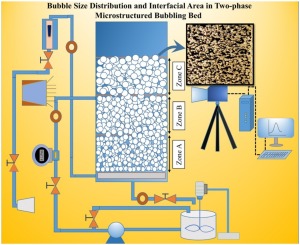Chemical Engineering Research and Design ( IF 3.9 ) Pub Date : 2020-01-31 , DOI: 10.1016/j.cherd.2020.01.032 Ritesh Prakash , Subrata Kumar Majumder , Anugrah Singh

|
The present work reports the investigation of flow regime, bubble size and its distribution, bubble aspect ratio and interfacial area in three distinct axial zones of the microstructured column in the presence and absence of the surfactant. The effect of surfactant type (i.e., cationic and anionic), superficial gas velocity, viscosity (in the presence of carboxymethyl cellulose), and the axial zone is investigated thoroughly. The image analysis technique is used to measure the bubble size in the gas distributor region and region of fully developed flow in the column. The bubble size distribution is found to vary with different experimental conditions, and it follows the log-logistic and beta distribution function. The observed results show that the change in the surface tension, axial zone, and viscosity of the system change the bubble shape and size, which alters the bubble size distribution, thus, enhance the interfacial area. Correlations are developed by considering the operating (i.e., gas velocity) and geometric variables (viz., column geometry, aspect ratio), and physicochemical properties (i.e., surface tension, viscosity, density) of the system for all the distribution parameters of the distribution function. Generalized empirical correlations are also proposed to interpret the Sauter mean bubble diameter, aspect ratio and specific interfacial area for dense bubbly flows. The predicted results are in good agreement with the experimental data.
中文翻译:

两相微结构致密鼓泡床中的气泡尺寸分布和比气泡界面面积
本工作报告了在存在和不存在表面活性剂的情况下,对微结构化塔的三个不同轴向区域的流动状态,气泡大小及其分布,气泡长宽比和界面面积的研究。彻底研究了表面活性剂类型(即阳离子和阴离子),表观气体速度,粘度(在羧甲基纤维素存在下)和轴向区域的影响。图像分析技术用于测量气体分布器区域和色谱柱中充分展开的流动区域中的气泡大小。发现气泡大小分布随不同实验条件而变化,并且遵循对数逻辑和β分布函数。观察结果表明,表面张力,轴向区域,系统的粘度会改变气泡的形状和大小,从而改变气泡的大小分布,从而增加界面面积。通过考虑系统的所有分布参数的操作(即气体速度)和几何变量(即色谱柱几何形状,长宽比)以及理化性质(即表面张力,粘度,密度)来建立相关性。分配功能。还提出了广义的经验相关性来解释稠密气泡流的索特平均气泡直径,纵横比和比界面面积。预测结果与实验数据吻合良好。对于分布函数的所有分布参数,系统的几何速度(气体流速)和几何变量(即柱几何形状,长宽比)和理化特性(即表面张力,粘度,密度)。还提出了广义的经验相关性来解释稠密气泡流的索特平均气泡直径,纵横比和比界面面积。预测结果与实验数据吻合良好。对于分布函数的所有分布参数,系统的几何速度(气体流速)和几何变量(即柱几何形状,长宽比)和理化特性(即表面张力,粘度,密度)。还提出了广义的经验相关性来解释稠密气泡流的索特平均气泡直径,纵横比和比界面面积。预测结果与实验数据吻合良好。


























 京公网安备 11010802027423号
京公网安备 11010802027423号